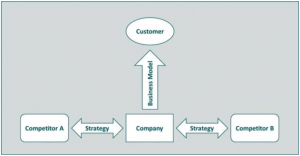Originally posted on LinkedIn
Sustainable business models as the holy grail of entrepreneurship
Business models are imbued within the very fabric of every enterprise, whether known or not. Often enterprises display several business models at once (think Amazon, Google etc.). Unfortunately, often enterprises are not aware or clear what their business model is. Somewhat of an ill-defined term, with a multitude of definitions, a business model is best thought of as an abstract construct that provides a holistic, systems-level view of the business logic, i.e. how an enterprise goes about its business (Zott & Amit 2011, Teece 2017, Magretta 2002). It seeks to explain what the value proposition is, how value is created, captured, delivered (Lüdeke-Freund et al. 2016) and destroyed (Yang et al. 2017)
This week it was reported the mass culling of Business models describe how an enterprise generates value. Some scholars argue this is akin to strategy and indeed represents the ‘other side of the same coin‘ (Braun et al. 2019). Others disagree, stating that business models fail to capture the effects of competition (Porter 1996), or that strategy entails a choice in the business model (Casadesus-Masan 2010). In essence, business models are seen as inward-facing, whereas strategy is outward-facing. I propose that business models, as a unit of analysis, should do both in its service to society and the environment. Importantly, business models should capture both the supply and value delivery chain, and thus explain the positioning of the enterprise within the greater sustainable value network (Evans et al. 2017). Here again, a number of approaches exist and tools have been developed to describe business models and categorize the same. Descriptive tools include the business model canvas (BMC) (Osterwalder & Pigneur 2010) and the flourishing business canvas (FBC) (Upward & Jones 2016).

How do we determine which combination of business model patterns are likely to succeed? What strategy makes a business sustainable? What is known is that alongside product and process, innovations of the business model – known as business model innovation – towards sustainability does lead to sustainable business models (Schaltegger et al. 2016). Successful business model innovation is a process of ideation, implementation, and impetus towards sustainable business models (Breiby & Wanberg 2011). Thus measuring and reporting the effects of business model innovation holds the key to understanding long-term sustainable business success.

A range of reporting standards exists from simple disclosures through to context and science-based assessments, onto modelling systems by metrics platforms like THRIVE (Fedeli 2019). The key question still remains as to how to determine, categorize and classify sustainable business models which often appear in the form of narratives in corporate reporting. Complex modelling platforms like THRIVE use machine learning to help discover long-term trends, whereby certain types of business model innovation strategies – within certain industries or sectors or regions – are found to perform better than others (Maltz et al. 2018).
Given the vastness of datasets requiring interpretation and sense-making and the complexity and wickedness of the real-life challenges we face, a sophisticated simulation system with backcasting targets is paramount. Antony Upward, Acting Director of Practice and Research for the Planetary-wide FEI Network, sees this as necessary to avoid the ‘dangerous over-simplification‘ problems faced by many traditional business modelling systems. One thing we do know is that there is no sustainable enterprise in an unsustainable world (Baue & Thurm 2018), thus the future of successful entrepreneurship must include a deliberate emphasis on positive social and environmental impact over and above economic profitability.
As a result of being a serial entrepreneur in the innovation space for thirty years, I am often asked what is the next big thing: the next innovation. My feeling is that all enterprises should be social enterprises engaging in, or transforming to business models with a track record of success (Fedeli 2019). So if you are a new entrepreneur, what business model should you consider for your industry? Based on future backcast targets and all the available data worldwide, which business models are deemed to be more successful than others? Such an answer could well represent the “holy-grail” of business entrepreneurship. Drop-in at THRIVE project and find out for yourself.























